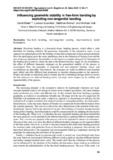Zitierlink:
http://dx.doi.org/10.25819/ubsi/10395Dateien zu dieser Ressource:
| Datei | Beschreibung | Größe | Format | |
|---|---|---|---|---|
| Maier_Influencing_geometric_stability.pdf | 735.08 kB | Adobe PDF |  Öffnen/Anzeigen |
| Dokumentart: | InProceedings | Titel: | Influencing geometric stability in free-form bending by exploiting non-tangential bending | AutorInn(en): | Maier, Daniel Scandola, Lorenzo Werner, Matthias Volk, Wolfram |
Institut: | Institut für Produktionstechnik | Schlagwörter: | free-form bending, non-tangential bending, heat-treatment, batch fluctuations | DDC-Sachgruppe: | 620 Ingenieurwissenschaften und zugeordnete Tätigkeiten | GHBS-Notation: | ZIR | Erscheinungsjahr: | 2023 | Publikationsjahr: | 2023 | Auch erschienen: | Engel, Bernd (Hrsg.): Transformation in der Biegetechnik : Tagungsband zum 6. Biegeforum Siegen : 24.-31. März 2023. Siegen: universi - Universitätsverlag Siegen, 2023. - ISBN 978-3-96182-155-6 - DOI http://dx.doi.org/10.25819/ubsi/10365, S. 65-71 | Zusammenfassung: | Free-form bending is a kinematics-based bending process, which offers a wide flexibility for bending arbitrary 3D-geometries. Especially in the automotive sector, it can represent an optimal process for the bending of structural components in high strength materials from the prototyping up to the series production, due to the reduction of tooling costs and the ease of process adjustment. Nevertheless, it still requires a complex design of the kinematics of the bending die in order to obtain the part in the desired tolerance range. In this contribution, the effect of different kinematic strategies on the geometrical stability of the process is investigated. First, the principles of tangential and non-tangential bending (under- and overbending) are described. Successively, the strategies are tested on different semi-finished parts before and after different heat treatments to simulate inhomogenities in the materials. Finally, the results are discussed, and it is found, that the overbending strategy allows to reduce the fluctuations in the obtained bending radius and angle, hence improving the stability and reproducibility of the process. |
DOI: | http://dx.doi.org/10.25819/ubsi/10395 | URN: | urn:nbn:de:hbz:467-26071 | URI: | https://dspace.ub.uni-siegen.de/handle/ubsi/2607 | Lizenz: | http://creativecommons.org/licenses/by-sa/4.0/ |
| Enthalten in den Sammlungen: | Universi |
Diese Ressource ist urheberrechtlich geschützt. |
Seitenansichten
300
checked on 03.04.2025
Download(s)
61
checked on 03.04.2025
Google ScholarTM
Prüfe
Prüfe
Diese Ressource wurde unter folgender Copyright-Bestimmung veröffentlicht: Lizenz von Creative Commons


